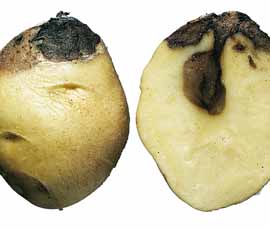Haulm destruction method not related to blackleg

Extreme blight pressure and the concern about a new blight strain this season has caused anxiety in the potato industry, but at a mid-season update at the Potatoes in Practice event, near Dundee, it’s not all doom and gloom
Two years of trials have shown no increased risk of blackleg when using a mechanical method of haulm destruction.
The use of diquat for desiccating haulms was compared with pulverisation over 10 different sites with varying disease pressures. “Pulverising was also carried out under all weather conditions,” said Matthew Smallwood, senior potato consultant at the SAC.
“There was no significant difference in bacterial levels on the daughter tubers after harvesting, when comparing mechanical and chemical haulm destruction.”
Mr Smallwood did acknowledge, however, that growers are increasing the risk of spreading the bacteria that causes blackleg when pulverising in wet conditions.
“In theory it can distribute the bacteria across the ridges, which can then be washed into the soil and on to tubers, but we have found little evidence of this in the study.
“The bacteria does not survive for long without a host, so unless you are pulverising before rain, there shouldn’t be an issue with the spread of disease.
“Therefore, our advice would be to only pulverise in dry conditions and when no rain is forecast in the following few days, especially in pre-basic crops,” said Mr Smallwood.
During the trials researchers also monitored whether it affected the occurrence of pit rot and gangrene in storage.
“Pulverising the haulm will significantly reduce the risk of pit rot and is recommended where susceptible varieties are grown or where there is a lush, green canopy with wet ridges,” said Mr Smallwood.
“We have also seen the same relationship with gangrene, so pulverisation would again be recommended where there is a risk,” he added.
Read more from the Potatoes in Practice event

